What do all those letters mean under the picture of that cute French Bulldog puppy?
The short answer – They are the color genes/DNA a dog expresses (what you visually see/phenotype) and carry (color/pattern that can be passed to offspring, but not visually seen/genotype). Each letter or letter combination gives a dog their coat color and pattern.
Thankfully through genetic testing we know what color/pattern the offspring of two parents will be and can reduce genetic defects by never breeding merles together. There is a really great app called, Color My Frenchie, you can enter the genotype (all the weird letters) and it will show you the phenotype (what the dog will look like). The app will also calculate the offspring percentages based on parents. It's pretty slick!
The long answer – Keep reading!
Honestly, if you’re not planning to breed it doesn’t even matter! However, if you’re curious about Frenchie color because you’ve seen all the media surrounding the “no fad colors” movement. See my blog about health and color called Color Conflict.
Now all that being said… If you plan on breeding, those letters can make a huge difference in puppy selection or the parents you match with for breeding! I can’t say enough about doing research, research, research prior to breeding. I spent years learning, readying, talking to people prior to breeding (especially with finicky French bulldog breeding) and I was already very familiar. I think genetics is one of the coolest things about breeding any animal, whether it be a dog, cat, alpaca or reptile. It doesn’t get any better than pairing two exceptional animals and ending up with even better offspring!
Let’s get down to the nitty gritty of what you came here for. What do these letters mean individually and also when they are paired together. Other breeds have similar letting but what I’m discussing is specific to French Bulldogs.
It is important to note that each trait is made up of two letters (alleles), one given by each parent. There are also dominant traits that will be expressed with only one gene passed by one parent and recessive traits that need two genes to be expressed, one from each parent. To make things even more complicated, some genes work with other genes to change the way coat color or patterns are expressed.
A-Locus (Pattern)
The A-locus (Agouti) has three possible options (alleles), Ay - Fawn, At - Tan, a - solid.
Possible Combinations:
- Ay/Ay (2 copies) - Fawn base if Ky/Ky, Black if carries just one brindle gene
- Ay/At (1 copy fawn, 1 copy tan points) - Fawn base if Ky/Ky, Black if carries just one brindle gene, carries Tan Point
- At/At (2 copies) - Tan Point base
- At /a (1 copy tan points, 1 copy solid) - Tan Point base and carries solid
- a/a (2 copies) - Solid, not Fawn, the K-locus doesn't have an effect
The A locus is in charge of base color, either black or red (Fawn) fur pigment. It's also one of the most confusing Locus due to it working in combination with other genes. The Ay allele is a dominant gene and will make the dog fawn with any other "A" combination. There are exception to this, as this gene works in combination with the K-Locus and can be covered by the E-Locus. If the dog carries even one brindle gene (Krb) it will not be fawn. Also, if the dog is ee it means its covered in cream and will not express any color, fawn or tan point.
Combinations of At/At or At/a will be a dog with tan points. Tan points are expressed by light color patches on their cheeks, eyebrows, chest, and legs. (see pictures below)
A solid dog needs both "a" copies from each parent as this gene is recessive.
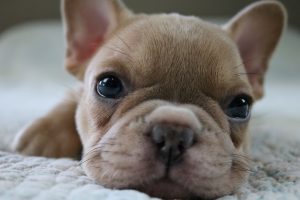
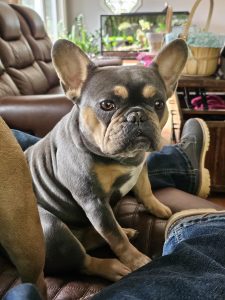
K-Locus (Black/Brindle)
The K-locus has only two possible alleles Kbr - Brindle and Ky- Black.
Possible Combinations:
- Ky/Ky (no copies) - no brindle
- Kbr/Ky (1 copy) - brindle and cannot be fawn even if Ay on the A-Locus
- Kbr/Kbr (2 copies) - brindle and cannot be fawn even if Ay on the A-Locus
The K locus has a large impact on coat color depending on the other genes a dog carries on the A locus.

D-Locus (Blue)
The D-locus has two alleles the dominant D - Black or recessive d - blue.
Possible Combinations:
- D/D (no copies) - dilute gene is not present, Black
- D/d (1 copy) - dog carries dilute but does not display it, Black
- d/d - (2 copies) - dog displays dilute, Blue
The D locus is the dilute gene. It's responsible for reducing the saturation of coat color. Changing the black to a blue. When combined with other alleles it can change the coat color even more, such as co/co (lilac) and b/b (Isabella) or co/co and b/b (New Shade Isabella).
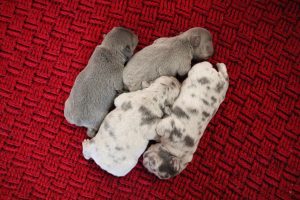
E-Locus (Cream)
Possible Combinations:
- Em/Em (2 copies of Mask) - masked
- Em/E (1 copy of Mask) - masked
- Em/e (1 copy of Mask, 1 copy of Cream) - the dog will have a mask but carries cream
- E/E - maskless
- E/e (1 copy of cream) - maskless and carries cream
- e/e (2 copies of cream) - visually cream and can cover other colors
The E locus is responsible for two things, the mask and cream. A masked dog will have a dark muzzle and a maskless will have a light-colored muzzle. The difference is most clearly seen in tan points and fawns. The muzzle will have brown instead of black or blue.
If a dog carries two copies of the recessive e-allele it will cover any color in cream. You will still see pied marking come through on a cream. Knowing the genetic color of your dog is near impossible unless you've done a DNA testing. Even knowing the parentage color DNA may not give you the exact color if there are different coat color options for the littler. When the cream gene is combined with dilute d genes you have what they call platinum. If you go even further and combine cream, blue and chocolate genes (lilac platinum or Isabella platinum) you can have even lighter color dogs with pink noses and foot pads.
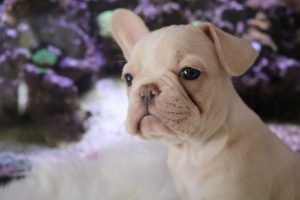
B-Locus (Brown / Testable Chocolate)
Possible Combinations:
- B/B (no copies) - no "brown" dilution
- B/b (1 copy) - No "brown" dilution, but a carrier
- b/b (2 copies) - dog is a "brown" dilution
The B locus changes the coloration from the A and K locus to a shade of brown. This is a recessive gene which needs two copies to be expressed visually. Dogs that are bb and dd are called Isabella. New Shade Isabella is when a dog carries dd, bb and the cocoa genes. Dogs that are ee as well as bb will have light brown noses and foot pads instead of black or blue.
Cocoa (Brown / "non-testable")
Possible Combinations:
- Co/Co (no copies) - no "brown" dilution
- N/co (1 copy) - No "brown" dilution, but a carrier
- co/co (2 copies) - dog is a "brown" dilution
The Co locus changes the coloration from the A and K locus to a shade of brown. This color is formally known as "non-testable chocolate". Dogs that are also bb tend to have a lighter coat color. A dog that is both co/co and b/b are called a lilac. Sometimes people use the term lilac for just standard blues because they are a light blue. Even though they may be lighter than another blue, if they don't carry two copies of the cocoa gene they are not a lilac. Be careful when purchasing a puppy as a lot of breeders market as lilac when they are not. This is a recessive gene which needs two copies to be expressed visually.
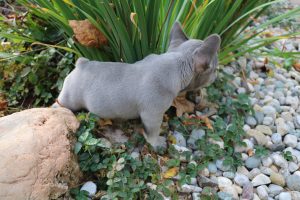
S-Locus (Pied)
Possible Combinations:
- N/N - (no copies) – does not carry Pied
- N/S (1 copy) - carries but is not visual as pied or very little
- Sp/Sp (2 copies) - pied
The S Locus is the piebald gene in French Bulldog DNA. It requires both copies to be present for a dog to be pied. You may see some white on the head or chest of dogs that are just carriers, but they will not be fully pied. In other breeds it only requires one copy of the gene. This gene removes pigment in random locations on the body resulting in large white patches with spots of color.
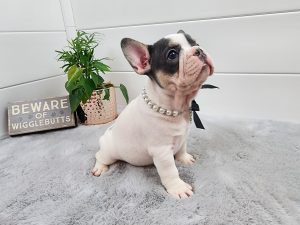
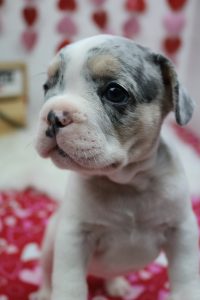
Merle
Possible Combinations:
- N/N (no copies) - no merle.
- M/N (1 copy) - dog is merle.
- M/M (2 copies) - Double merle and should NOT be done! Great risk of hearing and vision deficiencies.
The merle allele is dominant. Any dog with one copy of the merle gene will be merle. Merle is about the only color that may keep their bright blue eyes after puppyhood. May be one or both eyes or just flecks of blue in the eye. Merle can also be hidden under other colors or be so minimal it's not noticed. DNA testing is always recommended for any dog prior to breeding, however it's even more important when one of the parents is merle.
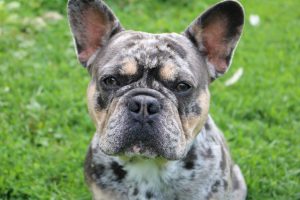
Fluffy
Possible Combinations:
- L/L (2 copies) - long hair
- L/n (1 copy) - short hair, but carries long hair gene
- n/n (no copies) - short hair
The L locus (FGF5 gene) is responsible for the coat length. There are at least 5 known alleles L, L2, L3, L4 and L5. It appears that french bulldogs carry the L1 and L4 genes for long hair. It doesn't matter which allele they have. If they have two of either allele, they will be fluffy! Be cautious when testing for fluffy, because some tests claim to test hair length but don't test for all the alleles. I was burned by Embark! It might change, but as of me writing this blog, they only test for the L1 allele. I was unaware of this, because they don't disclose it up front. I found out after testing! The allele I was testing for was the L4 which they do not test for. (update: as of 2024 Embark is testing L1-L4 genes)
I-Locus (Intensity)
Possible Combinations:
- N/N (no copies) - no dilution, darker color
- In/N (1 copy) - dog carries dilution but not much color change, if any
- In/In (2 copies) - dilution, lighter color
The I locus is new and still being ironed out. It seems to change the color by lightening the fur. I saw this difference firsthand with my "Family" litter. I had 4 boys that were all blue fawn. Two carried intensity and two did not. As they were developing their color was dramatically different with only that intensity DNA difference. Two were very light, even for a fawn with a light blue mask. The other two were dark, kind of reddish with almost a black mask.
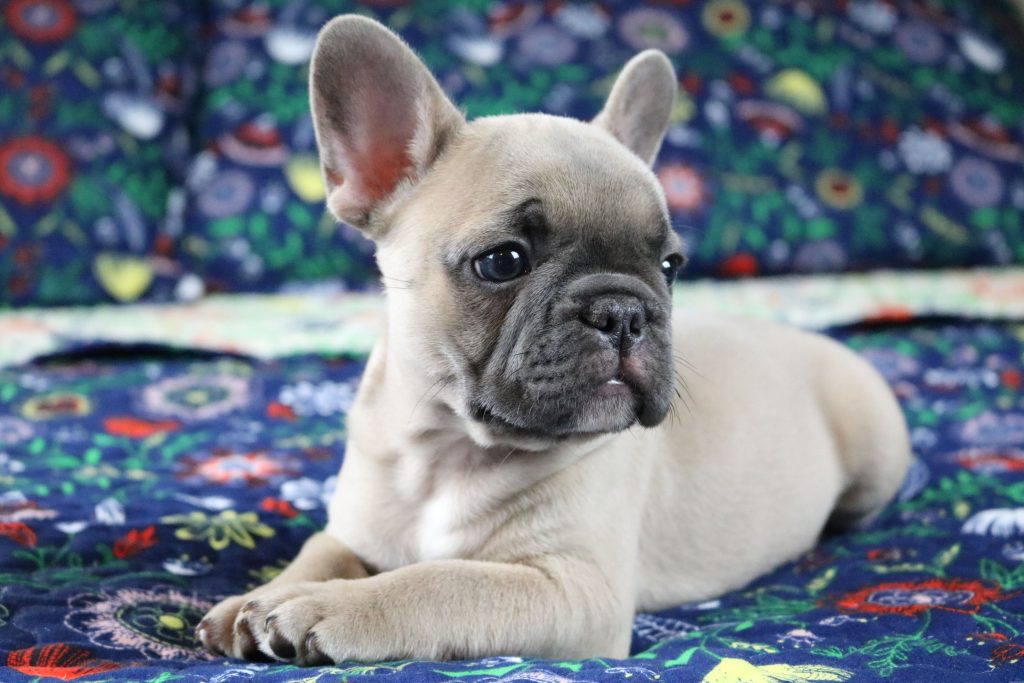
Both dogs are Blue Fawn Masked from the same litter. The puppy above carries intensity which dilutes the color to a light cream. The puppy below does not carry intensity which keeps the color a darker fawn.
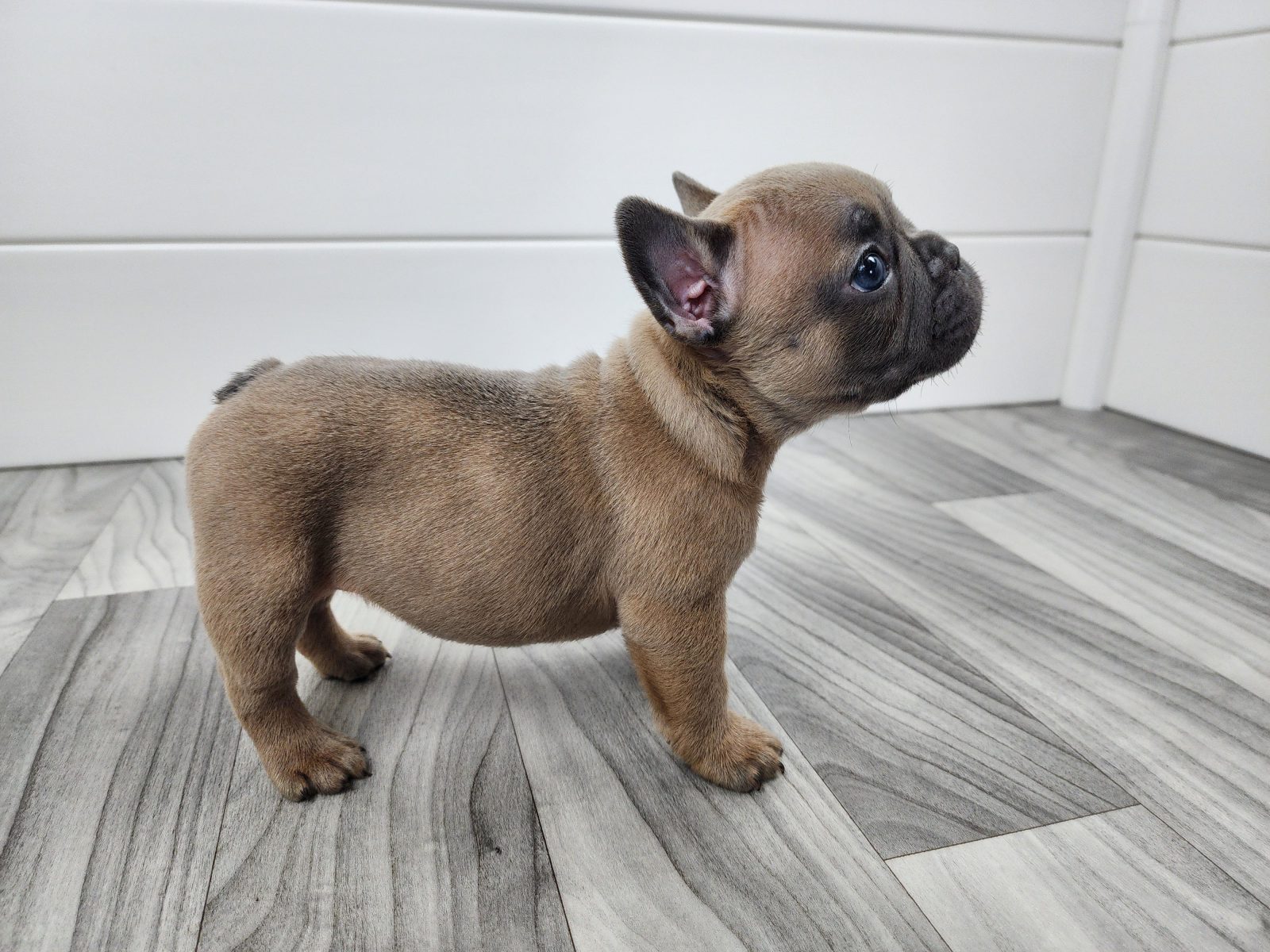
What determines eye color? – I get this inquiry a lot! "I want a pup with blue eyes!" Some breeders won't tell potential adopters, because they want to make that sale; However, most French bulldogs don't keep that beautiful crystal-clear blue you see in puppy eyes. Puppies are born with blue eyes and they change as they mature. The coat color can also drastically change from birth to a couple months old. I was convinced I had a blue litter once and they all ended up blue fawn a week later! Most french bulldogs have either dark brown or light brown eyes. When you get into chocolates and platinum, they can have more of a yellow starburst with a blue/green center. Their eyes are usually much lighter than standards or blues. Where you get your blue-eyed exceptions are those stunning merle coat patterned dogs! Depending on where the merle pattern falls in the eye; you could have both bright blue eyes, one bright blue eye and one normal eye or eyes that are brown flecked with bright blue. This is one of the reasons I find merles so interesting. My Ruxin boy has brown eyes and the right has a fleck of bright blue! Long story short, usually the lighter the coat color the lighter the eyes in non-merles, however they won't stay blue unfortunately.
What are the standard French Bulldog colors? – Per the American Kennel Club (AKC) official standard of the French Bulldogs:
Acceptable colors: white, cream, fawn (ranging from light fawn to a red fawn), or any combinations of the foregoing. Markings and patterns are: brindle, piebald, black masks, black shadings, and white markings. Ticking is acceptable but not desired. Brindle ranges from sparse but clearly defined black stripes on a fawn background to such heavy concentration of black striping that the essential fawn background color barely shows through (“black brindle”). Only a trace of the background color is necessary; in a brindle piebald, a trace of the brindle patterning in any patch is sufficient. All other colors, markings or patterns are a disqualification. Disqualifying colors and patterns include, but are not limited to, solid black, black and tan, black and white, white with black, blue, blue fawn, liver, and merle. Black means black without a trace of brindle.
Why aren't all the color alleles (letters) listed on a dog? – There are a few reasons for this. It could be it wasn't tested for, like fluffy or intensity. Those are still newer tests that not every company test for yet. It also might be left off if it's something you can obviously see, such as pied. Another reason could be because it's not a carrier. For example, if the dog isn't a chocolate carrier, cocoa and dd might not be listed because it's not a highlight. Most of the time you can assume if it's not listed, they are not a carrier for that gene. When in doubt and you're looking for that perfect puppy or stud, just ask the owner. You never want to assume when it will effect your breeding program. It could bite you in the butt later! If the lettering is confusing or doesn't make sense, it also might be a scam. Especially if you start asking questions and the breeder or stud owner can't answer them, it's an automatic red flag!

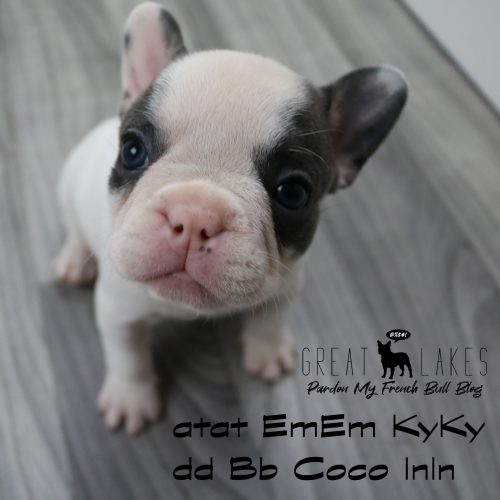
Is the demand for blue French bulldogs contributing to unethical breeding practices and health issues within the breed?
This is a really great question. In my opinion, I don’t think it is. Bad people breeding for incorrect reasons happens in all breeds, with all colors. I’ve seen standard color breeders, breeding dogs that can’t breathe. I don’t think color matters, it’s the quality and morals of the breeder. I’m really glad the trend of hairless French Bulldogs never caught on, because I do think that is unethical breeding. That is an example of creating health problems to become the next “it” French Bulldog. Blue has been in the French Bulldog population for a VERY long time. I’m honestly surprised it hasn’t been made a standard color with AKC. Years ago, they were rarer, however now it’s easier to find a blue French Bulldog than a standard color. I touched on the issue of non-standard French Bulldog colors in my blog, Color Conflict. I did (and continue to do) a lot of research with color. Especially, because I prefer non-standard colors. There is no link between the dilute (blue) gene and health issues. There are so many dilute or dilute carriers that without the blue gene in the breeding gene pool for French Bulldogs the genetic variety would be extremely limited and would be a detriment to the population. Sorry I gave a very complicated answer to a simple question. lol. It’s a hot topic for a lot of breeders!
My puppy is a very different color than I have seen. Her mom is lilac and dad blue cream with chocolate gene. She is light cream with clue shading in her coat, ears and mask. She has blue eyes
How can we ensure that breeders are accurately representing the genetic makeup of their adult dogs, especially when certain traits or carriers are not listed in their pedigrees?”,
“refusal
Only use breeders you trust are representing their dogs accurately by breeding only registered parents, DNA testing and know the pedigree of their dogs. The only way you can truly 100% know the genetic makeup of a dog is to send the DNA test yourself somewhere like Embark or Animal Genetics.
I have two dogs a blue merle and a solid blue that both passed the 6 panel from animal genetics. They’re from different litters. When I told the woman who sold them, she upped the price of the remaining puppies lol.
My solid blue (no white or anything) has d/d, 1 copy b, 1 copy co, a/a (I believe that’s black).
My merle confuses me a little lol. it says AY/at. It says that’s fawn/sable and carries tan points. He has d/d, n/M (merle), n/KB saying both KB and negative alleles detected, dog can be brindled or express only the base coat, and last n/S.
My confusion is the brindle and base coat. He’s pretty much a merle with blue and has some type of real light brownish or fawnish idk how to explain it lol. I don’t see any brindle or tan point on him. I understand the d/d gene can cover colors but I thought a copy of brindle would show or is the merle gene stronger? How come thar fawn/sable gene showed if I only see one copy of it but the tan points didn’t show and I only saw one copy of that lol. I know health wise they’re a great pair and she has pretty great bones (my blue). I think that’s pushing the breed forward pairing them. His eyes are light too (my merle).
Since some of his coloring didn’t show, if I breed them what should I expect? Since they’re negative for everything in the 6 panel test, I should 100% know that they’re offspring will be 100% negative as well, correct? Or could something pop up?
Thank you.
Genetics can get kind of confusing when you’re talking about multiple genes. Especially because some genes are recessive (you need copies of the same 2 alleles to be expressed) and some are dominant (you only need 1 copy of an allele and it covers whatever else is there). Different gene combinations work on the expressed color/coat patterns in different ways. Merle and brindle are both coat patterns. What your probably seeing on your merle is the blue color and merle coat pattern and the spots that are dark blue you have the base of the brindle (brown streaks) pattern as well. The tan point is carried but because he has both the ay and kbr you’re seeing the brindle come through and not solid blue tan point. Brindle (Kbr) is a dominant gene and will cover tan points (at). However, that gene can definitely be passed to the offspring and a is recessive to at so the offspring will be tan point. That’s also why solid color (aa) dogs are rarer!
That’s great you did genetic testing on both of them. Highly, highly recommend to all breeders. If they are 100% clear the offspring will be as well. Also, I love the solid girl! You don’t see a lot of solid colored frenchies. Usually they’re tan point, brindle or pied. The other thing I would make sure you do, that’s super important, if you’re going to be breeding a merle dog. Test your solid blue girl for the merle gene. You may have already if you went with a test like Embark, but its really important to make sure you don’t do a merle to merle breeding. The merle coat pattern can hide under other colors. I would assume she isn’t because I think you would see the pattern because she’s dark, however I don’t like to assume when it comes to health.
What you can expect from the pairing: Great pairing for a wide variety of expressed color- Blue Brindle, Blue Fawn, Blue Trindle, Blue and tan (no brindle) – Merle is dominant so 50% chance of merle in those colors. You didn’t mention if either carried maskless or cream so I didn’t figure that into baby options. That would be the E locus.
I hope this helps! Feel free to reach out if you have more questions. And if you decide to jump into the crazy breeding world, Good Luck and Good Health!!
Do you know what gene, L1 – L5 possibly, gets the new Floodle hypoallergenic long curly haired fluffies?
The genetics behind coat types and hypoallergenic traits in dogs are constantly evolving, and we’re learning new things all the time. I don’t know a lot about Floodles specifically or how breeders are approaching hypoallergenic or curly-haired Frenchies, so I don’t want to speak beyond what I truly understand.
In my own program, I breed French Bulldogs that carry the L1 and L4 long-hair genes, as well as some non-standard colors—but that’s as far as I plan to go when it comes to altering from the breed standard.
If you’re interested in the hypoallergenic aspect, I’d recommend chatting with a reputable Doodle breeder to learn more about what actually contributes to that trait. It’s important to know that mixing a hypoallergenic breed with a French Bulldog doesn’t automatically mean the puppies will be hypoallergenic.
Definitely do plenty of research if that’s a direction you’re considering—it’s a fascinating topic, but there’s a lot to learn before diving in!